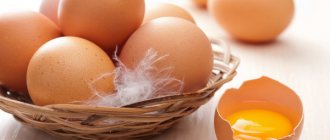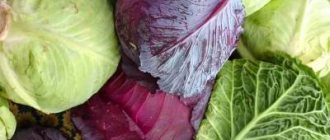For many years, cabbage has been an indispensable ingredient in kitchen dishes. This vegetable can be fermented and pickled, stewed, boiled and dried. In addition, cabbage is the basis for cabbage rolls and pies. At the same time, we should not forget that vegetables from the cabbage family have very finicky storage conditions, the observance of which, in turn, determines the shelf life. We have prepared material especially for you, which describes in detail the intricacies of storage and shelf life of everyone’s favorite vegetable.
Shelf life of white cabbage
The shelf life of cabbage is affected by its variety. Thus:
- Late-ripening varieties are best left for winter storage;
- Late ones are stored in the cellar for up to six months;
- But the early types of this vegetable crop are stored even less - only 90 days .
These expiration dates are relevant only for whole heads of cabbage, without rot, cracks or damage from pests. The vegetable should be stored at temperatures from -1 to +1 degrees Celsius and relative humidity up to 95%. If forks are constantly stored warm, shelf life decreases significantly.
The best place to maintain temperature conditions is the vegetable compartment of the refrigerator. If you need to preserve the juiciness of the vegetable for more than 90 days, you can wrap the heads of cabbage in food film.
When storing in places with average air temperature and low humidity, it is recommended to wrap the heads of cabbage in paper, maintaining a distance between them. Regardless of the storage location, the vegetable needs periodic observation and removal of spoiled leaves.
The maximum shelf life (up to a year) can be achieved by placing the head of cabbage in the freezer . To do this you need:
- Maintain temperature conditions (up to -18 degrees);
- Pay attention to proper packaging (if individual parts of the vegetable are stored in the freezer).
If used as an ingredient, white cabbage has the following shelf life and storage rules:
- When stewed, the shelf life is two days. Storage – in the refrigerator, at a temperature of +2 to +6 degrees Celsius;
- In pies - at room temperature for 72 hours, 90 days in the freezer and one week when stored in the refrigerator;
- In cabbage soup made from fresh cabbage in meat broth - 3 days, in chicken or mushroom broth - 24 hours;
- In sauerkraut cabbage soup – up to five days;
- In dried form – no expiration date (if properly dried).
The best place to store dishes containing cabbage is the refrigerator. If necessary, you can use the freezer.
Choosing a variety for storage
In order to preserve the harvest of white cabbage for a long time, it is important to choose the appropriate variety. Early types (“June”, “Skorosperaya”) are not suitable for long-term storage. They must be consumed within 2 months after ripening.
For storage , choose mid- and late-ripening varieties . Their ripening period is 130-150 days and 150-180 days, respectively. The ideal option is varieties that ripen in late summer or autumn. This cabbage will keep well in the cellar or refrigerator. It is also suitable for creating home preserves (pickling, pickling).
Of the mid-season varieties, cabbage “Aquarelle”, “Vyuga” and others are well preserved, and of the late varieties - “Morozko”, “Amager 611”, “Crumont F1”, “Kolobok F1”, “Lezhkiy F1”, “Zimovka 1474”, “ Prestige F1" and others.
To store cabbage for the winter, choose late-ripening varieties. They are distinguished by their dense structure and keeping quality.
Shelf life of sauerkraut
If you decide to ferment cabbage, you will probably be interested in knowing the storage conditions and shelf life of such a product. So, the shelf life of the product is affected by:
- Choosing a cabbage variety;
- Availability of additional ingredients;
- Correct calculation of brine strength and addition of spices, salt and sugar;
- Caring for cabbage for the first few days after the start of fermentation;
- Periodically adding sugar;
- Storage in glass containers.
In a refrigerator
- In a tightly closed container, at a temperature from 0 to +5 degrees – up to 90 days;
- When adding sugar, lingonberries or cranberries – up to 8 months;
- In an open container – no more than 12 days;
In the freezer
- In the freezer - up to a year;
- At room temperature: 72 hours;
- On the balcony, in the cool season: 4-5 months.
Harvesting rules for long-term storage
The timing of harvesting white cabbage depends on the variety, growing region, and weather conditions. Varieties suitable for storage:
- mid-season - growing season 130-135 days, stored for 3-4 months;
- medium-late - ripen in 140 days, retain taste for up to six months;
- late ones - grow for 150 days or more; in suitable conditions, shelf life is 8-9 months.
In central Russia, cabbage is harvested from the second half of September to the third ten days of October. In the climatic conditions of Siberia and the Urals, where night frosts begin early, harvesting begins in the first ten days of September.
Before harvesting, you need to make sure the cabbage is ripe, since ready-made forks last longer and dry out less. Signs of a ripe head of cabbage:
- the plant has stopped developing;
- the fork is dense, its surface is smooth and shiny, when squeezed the leaves emit a characteristic crunch;
- the covering leaf plates acquire a bluish tint;
- the lower leaves turn yellow.
The optimal temperature for harvesting vegetables is +4-6°C. Harvesting in hotter weather reduces shelf life. Short-term frosts are not dangerous for cabbage, but at night frosts from -6°C and below, the forks freeze and become unsuitable for storage. If the cabbage is frozen, you need to leave the crop standing for 4-5 days, allowing the heads of cabbage to thaw completely.
They stop watering cabbage 2 weeks before the expected harvest date. Choose a sunny day without precipitation. Depending on the storage method, the cabbage is carefully dug up with a shovel or cut with a sharp knife or chopped with a hatchet. At least three covering leaves and a stump 4-5 cm long are left on the head of cabbage.
Shelf life of cauliflower
- Cauliflower has different storage requirements and shelf life from its white cabbage counterpart. We recommend storing the vegetable in the refrigerator, in special boxes at a temperature of 0 to +2 degrees, at a relative humidity of up to 95% for no more than 2.5 months ; at temperatures up to +5 no more than 60 days .
- When stored in the freezer , the shelf life is six months . A vegetable that has been blanched (scalded) retains its properties for one year . Remember, cauliflower does not like damp rooms or exposure to sunlight.
How to store cabbage in the cellar until spring
You can store cabbage until spring in the cellar at a temperature of −1...+1 ℃ and an air humidity of 85-95% . Creating a favorable microclimate will protect the vegetable from rotting and help preserve juiciness, taste and the whole range of nutrients.
Before storing cabbage in the cellar, thoroughly clean, ventilate and dry the room . If necessary, disinfect and destroy rodents and other pests.
There are different ways to store cabbage in the cellar. The choice depends on the amount of harvest, the size of the room and the preferences of the housewife.
A simple way to store is in boxes . Before planting, cut off the stalks (3-4 cm should be left) of all heads of cabbage; do not remove the top layer of leaves. Place the cabbage in wooden boxes that have ventilation holes. Place the workpieces in the cellar, placing them on a stand or pallet. This will protect the product from excessive moisture and protect it from rotting.
A simple and economical way to store cabbage is in boxes. An important condition is the presence of ventilation holes in the container, which will ensure good air circulation and protect the crop from rotting.
Sand will help preserve the maximum nutrients in cabbage . Peel the heads of cabbage from the top layer of leaves (keep 2-3) and cut off the stalk (keep 3-4 cm). Place the products in a box and sprinkle each layer with sand, which must first be dried and calcined. This method is quite effective, although dirty.
You can store cabbage in the cellar in the form of a vegetable pyramid . Place a pallet or knocked down boards on the floor so that there is a gap between them. This will ensure air circulation and extend the shelf life of vegetables. Place the largest and densest heads of cabbage on them, then the medium ones in a checkerboard pattern and then the small ones. The result should be a stable vegetable pyramid.
You can store cabbage in paper . This method will provide thermal insulation and protect the fruits from moisture, light and contact with other vegetables. Wrap selected whole heads of cabbage in several layers of paper and place in boxes or bags. You can store such a blank in a cellar or basement.
Do not use newspaper to wrap cabbage. Printing ink contains harmful substances (such as lead) that can be hazardous to health.
Cling film will help preserve cabbage . Pre-sort the vegetables and remove the top leaves. Carefully wrap each head of cabbage tightly in film (in three layers). The created vacuum will protect the vegetable from pathogenic microorganisms, pests and negative environmental influences. Place the prepared vegetables on shelves in the basement or put them in boxes.
An unusual way to store cabbage is hanging :
- Nail a wooden board in the cellar and drive nails into its side at equal distances.
- Tie a rope to the stalk of each head of cabbage.
- Hang the cabbage on nails.
Such storage will ensure constant ventilation of the vegetables and prevent them from rotting. In addition, with this method it is convenient to monitor the condition of the cabbage and use first of all the one that has begun to lose its presentation.
Check the crop periodically and select heads that show signs of rotting or spoilage. Rotten areas should be cut off and the good part used in cooking as quickly as possible.
To preserve cabbage for a long time, choose late-ripening varieties, carefully select and sort the products, and also create a favorable microclimate for the vegetables.
Shelf life of Chinese cabbage
Cookbooks from Asian countries and beyond require that dishes contain Chinese cabbage. To ensure that the ingredient pleases with its taste and juiciness, quality standards offer the following storage conditions:
- For late varieties - in the refrigerator, at a temperature from 0 to +2 degrees, for no more than 30 days;
- For early varieties - under similar storage conditions no more than 2 weeks;
- Regardless of the variety - in the freezer, down to -18 degrees for no more than six months from the date of purchase;
- At room temperature – from 12 to 24 hours.
We do not recommend storing Chinese cabbage at temperatures above +5 degrees. Please note that heads of cabbage that ripen in mid-autumn are best suited for long-term storage.
Which cabbage should not be chosen for storage?
In addition to the variety, when choosing cabbage for storage, I pay attention to several other factors. You should not try to save a head of cabbage for the winter if it:
- not fully formed;
- damaged by pests such as slugs or caterpillars;
- loose to the touch;
- affected by a disease caused by fungi or bacteria;
- has mechanical damage received during assembly;
- caught by frost;
- has cracks or other defects.
Damaged heads of cabbage lie very poorly. They must be rejected and consumed first. I throw away cabbage that is severely damaged by diseases without sparing, so as not to infect other heads of cabbage and poison myself.
Head of cabbage affected by mold
Cabbage after expiration date
If cabbage or dishes containing it are stored in inappropriate conditions, there is a high risk of spoilage. For cabbage they are:
- The leaves dry out or turn black;
- Slugs are found in the cabbage;
- The head of cabbage may look normal, but inside it is affected by rot;
- Change in color and smell.
Vegetables with these and other signs of spoilage are not recommended for consumption.
As for dishes with cabbage, in case of spoilage:
- An unpleasant odor appears;
- Mold and slime may form.
We do not recommend consuming expired food. If you experience discomfort after eating foods containing cabbage, consult your doctor.
When to put it away for storage?
If you store the heads of cabbage too early, the vegetables will wilt. Delaying the torque will cause cracks in the forks.
Therefore, you need to follow several rules:
- Harvesting begins when the air temperature during the daytime is +3...+8 degrees, and at night drops to 0...-3 degrees.
- The weather should be dry. When it rains, forks are not cut off.
- After harvesting, the heads of cabbage are dried in a warm room with good ventilation, or outside under a canopy.
Cabbage that is planned to be stored for a long time is cut only with a sharp knife. There is no need to completely cut off the stalk; the length of the stem should be 3 cm. Also leave the top 2 leaves. They will protect the vegetable from moisture loss, disease and damage.
Results
We looked at the expiration dates and storage rules for the most popular varieties of cabbage. As theory shows, storing vegetables and dishes containing them is not an easy matter. In practice, everything is much simpler. Follow storage rules, do not eat expired food and do not use spoiled heads of cabbage for cooking.
Remember:
- That a vegetable affected by pests is not intended for storage;
- About the importance of periodic inspection of long-stored heads of cabbage;
- About the need for timely removal of dry and darkened leaves.
Preparation
How to store cabbage at home in winter? The most important step in ensuring long-term storage of cabbage is preparation.
It doesn’t matter in what way or in what room you plan to store this vegetable, it needs to be prepared.
Preparation for storage consists of the following steps:
- Choose the best heads of cabbage.
Only the strongest, most complete, high-quality ones are subject to storage. Proper cleaning is important. They must be healthy and not eaten by pests, without signs of rot.There should be no cracks on the forks, especially deep ones. Heads of cabbage that are unsuitable for storage are best consumed first. There is no point in leaving them for the winter, they will not last long;
- Cut off all excess.
To store cabbage at home, in any case, you need to cut off the stem and remove one layer of the top leaves.Don’t get carried away and “undress” the cabbage too much. The upper leaves perform a protective function. Read how to properly harvest white cabbage here.
- Wash the selected heads of cabbage under running cool water to eliminate the presence of soil or insects between the leaves. After this procedure, the cabbage should be thoroughly dried with a towel.
A good head of cabbage, suitable for storage
Heads of cabbage, processed and stored
Remember that late varieties of cabbage, which are removed from the beds before the first frost, are best suited for long-term storage.
Further preparation depends on the chosen storage method. Read more about storing white cabbage on our website.
Possible problems and ways to overcome them
If the cabbage begins to rot, remove the top spoiled leaves and powder the heads with crushed chalk. As a rule, the spoilage process is slowed down, but such forks need to be stored separately from the rest of the harvest.
If the leaves wither, it means there is a low level of humidity in the room . You can increase it if you place containers of water in the cellar.
Sometimes a large amount of concentrate forms under the film, which is an ideal environment for the growth of bacteria. Most often this happens because the heads of cabbage were wrapped warm and then put in a cold place.
Water is a consequence of temperature changes . Dealing with the problem is simple; just remove the old film and replace it with a new one.
How to choose the right neighbors?
There are vegetables that cabbage is “friends” with, so they can be placed in close proximity. These include:
- potato;
- beet;
- carrot;
- radish;
- pumpkin.
This does not mean that vegetables are placed in one box, but you can store them in close proximity to each other, although the greater the distance, the better.
The main rule is not to store cabbage next to apples. It is advisable that they are not in the room at all. Apples emit gas that speeds up the ripening of other vegetables and fruits, causing them to spoil quickly.
How to prepare cabbages for storage
In order for the harvest not to lose its quality for a long time, it is necessary to properly prepare the heads of cabbage. They begin cutting cabbage for storage from the moment the temperature drops to 0...+5 °C. Numerous studies have found that the respiration of cabbage heads collected at the specified temperature is less intense, due to which they are better stored.
Heads of cabbage should be collected on a dry day. If the weather is constantly rainy, then the heads of cabbage will need to be dried, and this is difficult and not always effective. You need to cut the cabbage with a very sharp knife, making sure to keep the stalks at least 3 cm long. If in the future the vegetable is stored hanging, then it is not cut, but pulled out by the roots.
You cannot completely tear off the covering leaves; you need to leave 2-3 pieces. They prevent the head of cabbage from mechanical damage and the penetration of pathogenic bacteria and putrefactive fungi into the edible part, which can completely destroy it.
It is also necessary to sort the collected heads of cabbage before storing. Cabbage should not be stored in the following cases:
- not fully formed;
- loose heads of cabbage;
- having damage;
- cracked;
- caught by frost;
- affected by diseases;
- damaged by pests.
After sorting, you can send the cabbage for storage. Rejected vegetables are sent for processing. If the head of cabbage is very badly damaged by disease, then it is better not to eat it.
Among the recommendations for collection and storage, it is important to follow the following step: before storing cabbage, if there is moisture on its outer leaves, the forks must be slightly dried.











